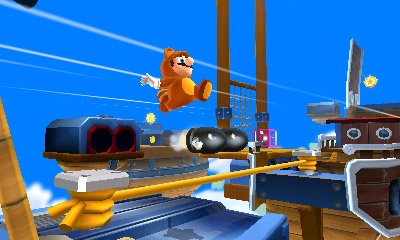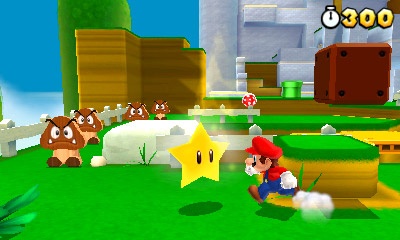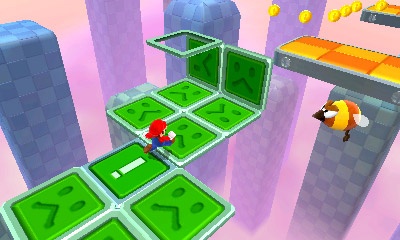Super Mario 3DS -- Yoshiaki Koizumi Q&A
We speak all things Super Mario 3DS, making changes to how Mario moves, why the Galaxy games drifted from the core Mario experience, and more with Nintendo's Yoshiaki Koizumi.
Nintendo's Yoshiaki Koizumi is one of the powerhouses of Japanese development, having a hand in either directing, producing, or writing such Nintendo classics as The Legend of Zelda: Ocarina of Time, Super Mario Sunshine, and both Super Mario Galaxy games. Koizumi's next project is the much-anticipated debut of the portly plumber on Nintendo's new handheld, Super Mario 3DS. We managed to catch up with Koizumi at this year's E3 to chat about taking Mario to the third dimension, how Mario changes from game to game, his thoughts on hint systems, and what he believes makes up the core of the Mario experience.
GameSpot AU: From what we've played of Super Mario 3DS so far, you seem to be playing a lot with perspective. There has been a lot of foreground to background movement when it comes to Mario traversing levels, and vice versa. What else do you have planned for the game?
Yoshiaki Koizumi: The effect of things coming from the background to the foreground was definitely something we wanted to use specifically because we could present it in 3D. When you're presenting someone with a fictional world, and you're trying to help them grasp how to move objects around inside of it, it was always very difficult, particularly on 2D displays, to show something coming from the background towards you. But now, we've gotten away from that taboo in development, and we now feel like we can use that effect more easily.
As for other effects, we're thinking of how objects will move in a 3D game and how they will move within a 3D display. We're thinking about several of them, but I'm afraid I can't reveal anything at this time.
GS AU: While playing, we also noticed that, at times, we were presented with a fixed view of Mario. When he moved behind some objects, he was obscured. Was this a deliberate move to get players to explore the world? Are you afraid people might lose track of the character in the level?
YK: We've been using this shadowed Mario silhouette ever since Sunshine. It's important in a 3D game to keep the player from losing the view of the character. In Sunshine, one of the solutions we had for this was to have the camera slowly rotate around the object that was obscuring the view of the character while it was still presented in a shadow silhouette. But we found that the camera movement tended to make some people queasy. We decided to fix this here by having a solution of a fixed camera and a constant presentation of the shadow.
GS AU: When you're designing a new Mario game, how much influence do fans have? The inclusion of the tanooki suit in Super Mario 3DS, for example, answers a lot of fans' calls. Do you listen to fans before you start development?
YK: I think it's important to note that our staff are all fans of the series as well, having grown up with Mario. And, as such, they're very familiar about what the traditional Super Mario game elements are and what makes it a fun experience. So we decided to focus on those few elements and culled the rest, to really get down to the essence. And of course, on that list the tanooki suit was very high. So I would say in that sense, yes, we do listen to fans when we design the game.
GS AU: The upcoming 3DS version of Ocarina of Time will feature a video hints system, while New Super Mario Bros. on the Wii also allowed you to skip past difficult sections. What do you think of such hint and help systems on a platformer, and are you planning to implement something similar in Super Mario 3DS?
YK: I feel like Ocarina of Time is a type of game that players can work through the puzzles even without this type of hint system. At the time, we were very satisfied with the challenge level it presented, even without hints. But looking back, we do recognise that there were some exceedingly difficult spots for players, so we're offering the hints in the form of video to help them out.
But ultimately, I feel that game design should strive for an experience that allows players to complete puzzles without the use of hints at all. And at the very least we should strive to make these puzzles fun to try repeatedly without hints--that's our ultimate goal.
GS AU: So how hard is it to design a puzzle or challenge that doesn't get frustrating to try over and over again?
YK: Of course Mario and Zelda games are very different kinds of experiences in the sense that Mario doesn't have the same type of puzzle-solving you'll find in a Zelda game. But that doesn't mean there aren't some parts of the game that are quite difficult. The important part is to design a challenging area of the game so that it doesn't feel like work if you have to do it more than once. So long as the experience is fun each time, I think players will still be satisfied.
GS AU: You worked on both Super Mario Galaxy games. Given the creative and gravity-defying ways platforming was approached in those games, does it feel more restrictive now to work on a more "traditional" Mario game?
YK: It's kind of strange. When I worked on Galaxy, as with every Super Mario game I always focus on the surprise and the newness of what we could bring to the gameplay experience. Perhaps that's just my personality.
While Galaxy had a lot of very interesting new features that weren't present in other games in the series, I feel like we also were able to sink down to some of the origins of the series at the same time. We put a lot of effort into it as we were working on it.
Similarly, this time I guess our approach is best described as focusing on how to bring the core essence of the Mario gameplay experience to a game that is presented in 3D. And this is taking us to lots of interesting new ideas that go even beyond what we did in Galaxy.
GS AU: So what is the core Mario experience?
YK: I feel like the core experience is something that we may have started to get away from a little bit when we first started presenting games in 3D like in Super Mario 64. The idea in those games is that you walk around in those environments and give the players a lot of opportunity to explore.
But the real basics of the Super Mario series is that players have to get to the goal of a level without dying. You have short levels with a very quick tempo, and it should be a very thrilling experience. So some of that was actually missing from Galaxy. The gameplay was a bit slower, and it was so much easier to die, so the core experience of getting to the goal without dying was harder to achieve.
This time around, you'll find that we have something closer to the three-minute levels you see in Super Mario Bros., so for me, overall this feels closer to the core of the Super Mario Bros. experience traditionally.
GS AU: Since Mario is so well known, people have an expectation of how he'll move and control. Does that place limits on how you can modify the character?
YK: It's interesting that you say that, because in Super Mario 64, Super Mario Sunshine, and Super Mario Galaxy, the jump height and distance was just a little bit different each time. And that's something we always do--we always tune those jumps and the way you control the character to the specific requirements of the game. Regardless, fans all along have, I think, found the game easy to play and found Mario easy to control as a result. And I hope that's because we were able to tune successfully each time.
As for giving Mario a new power, every time we want Mario to do something really super, we just create a new suit. Hopefully, we've been able to retain that Super Mario feel in those new additions, as well.
I do compare the old games fairly frequently. One thing I always notice was that Mario's foot speed seemed a little slow in Mario 64. That's something we wanted to get faster and faster, until eventually in Galaxy we had to dial it back a little bit. But we certainly look back and tune it as we start each new game.
GS AU: So Mario played around with gravity in Galaxy, and now he's moving into a 3D visual environment. Where is there to go for platformers from here?
YK: Clearly I can't make an out-and-out prediction. And I have to say that presenting Mario in a 3D display still has some secrets that I'll challenge myself to unveil. But I do look forward to the different types of experiences we can bring to the Wii U. Given that very interesting new hardware, I think we'll be able to do a lot with it, and we're exploring that right now.
GS AU: How do you feel about having the responsibility for making the next Mario? Does it keep you awake at night?
YK: I do occasionally have trouble sleeping through the night, but it's not necessarily because of the sense of responsibility I feel for the next Mario game. Probably the feeling I have while working on these games is a sense of accomplishment, because I'm so much aware of what we're bringing new to the series. If anything's keeping me up at night, it'll be the occasional idea that I come up with and can't get back to sleep.
GS AU: So where do you get your inspiration?
YK: I guess I find the inspiration for Super Mario games from regular life. Considering that Super Mario levels are so full of simple props and gimmicks you can interact with, things as simple as turning a knob or hitting a switch are the places you'll find inspiration for similar objects in the game.
I should also mention that because I commute by train, I spend a lot of time looking out the window, and sometimes the buildings that pass me by look like giant Mario courses. For example, I imagine one of those giant, spiky skewers coming out of a building and wondering how cool that would be.
GS AU: There has been a lot of buzz lately about the growth of gaming on mobile devices such as the iPhone and Android devices. Do you see mobile as an opportunity or a threat?
YK: I definitely don't see it as a threat. I feel if more people are brought to games through any means, it's something that makes me happy, it's definitely welcome. I think I would leave the worrying to others.
GS AU: Would a game like Mario work with a touch-screen device?
YK: When we were developing for the Wii and the DS, we actually tried to do a few experiments where people were touching a screen to jump. We feel it's important when making a Super Mario game, which is supposed to be accessible to a great many kinds of people, that you ask questions of those people. In that case, it turned out that buttons were the best option. But that certainly doesn't limit our thinking about new types of interfaces, and those new kinds of interfaces wouldn't necessarily need control pads or buttons, but we just don't know yet.
GS AU: Yoshiaki Koizumi, thanks for your time.
Got a news tip or want to contact us directly? Email news@gamespot.com




Join the conversation